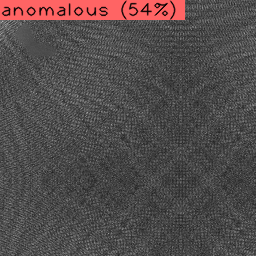はじめに
前回は anomalib のデモを試しました。
今回は、カスタムデータで学習する方法について説明していきます。
anomalib の github はこちらです。
前提条件
前提条件は以下の通りです。
- torch == 1.12.1+cu113
- pytorch_lightning == 1.9.5
カスタムデータの準備
カスタムデータは、以前の FastFlow の記事を参考に用意しました。
test, train フォルダを datasets/MVTec/custom フォルダへ保存します。
config.yaml の編集
次に、src/anomalib/models/padim/config.yaml を編集していきます。
dataset:
name: custom
format: folder
path: ./datasets/MVTec/custom
# category: custom
normal_dir: train/good
normal_test_dir: test/good
abnormal_dir: test/defect
mask_dir: null
extensions: null
# task: segmentation
task: classification
train_batch_size: 8
eval_batch_size: 8
num_workers: 2
image_size: 256 # dimensions to which images are resized (mandatory)
center_crop: null # dimensions to which images are center-cropped after resizing (optional)
normalization: imagenet # data distribution to which the images will be normalized: [none, imagenet]
transform_config:
train: null
eval: null
test_split_mode: from_dir # options: [from_dir, synthetic]
test_split_ratio: 0.1 # fraction of train images held out testing (usage depends on test_split_mode)
val_split_mode: same_as_test # options: [same_as_test, from_test, synthetic]
val_split_ratio: 0.1 # fraction of train/test images held out for validation (usage depends on val_split_mode)
tiling:
apply: false
tile_size: null
stride: null
remove_border_count: 0
use_random_tiling: False
random_tile_count: 16
model:
name: padim
# backbone: resnet18
backbone: wide_resnet50_2
pre_trained: true
layers:
- layer1
- layer2
- layer3
normalization_method: min_max # options: [none, min_max, cdf]
metrics:
image:
- F1Score
- AUROC
pixel:
- F1Score
- AUROC
threshold:
method: adaptive #options: [adaptive, manual]
manual_image: null
manual_pixel: null
visualization:
show_images: False # show images on the screen
save_images: True # save images to the file system
log_images: True # log images to the available loggers (if any)
image_save_path: null # path to which images will be saved
mode: full # options: ["full", "simple"]
project:
seed: 42
path: ./results
logging:
logger: [] # options: [comet, tensorboard, wandb, csv] or combinations.
log_graph: false # Logs the model graph to respective logger.
optimization:
export_mode: null # options: torch, onnx, openvino
# PL Trainer Args. Don't add extra parameter here.
trainer:
enable_checkpointing: true
default_root_dir: null
gradient_clip_val: 0
gradient_clip_algorithm: norm
num_nodes: 1
devices: 1
enable_progress_bar: true
overfit_batches: 0.0
track_grad_norm: -1
check_val_every_n_epoch: 1 # Don't validate before extracting features.
fast_dev_run: false
accumulate_grad_batches: 1
max_epochs: 1
min_epochs: null
max_steps: -1
min_steps: null
max_time: null
limit_train_batches: 1.0
limit_val_batches: 1.0
limit_test_batches: 1.0
limit_predict_batches: 1.0
val_check_interval: 1.0 # Don't validate before extracting features.
log_every_n_steps: 50
accelerator: cpu # <"cpu", "gpu", "tpu", "ipu", "hpu", "auto">
strategy: null
sync_batchnorm: false
precision: 32
enable_model_summary: true
num_sanity_val_steps: 0
profiler: null
benchmark: false
deterministic: false
reload_dataloaders_every_n_epochs: 0
auto_lr_find: false
replace_sampler_ddp: true
detect_anomaly: false
auto_scale_batch_size: false
plugins: null
move_metrics_to_cpu: false
multiple_trainloader_mode: max_size_cycle
batch_size や num_workers は適宜設定してください。
学習の実行
学習は以下のコマンドで実行できます。
python .\tools\train.py --model padim
最後に結果が表示されます。
結果の確認
結果の確認は、以下のコマンドで実行可能です。
python tools/inference/lightning_inference.py --config src/anomalib/models/padim/config.yaml --weights results/padim/custom/run/weights/lightning/model.ckpt --input .\datasets\MVTec\custom\test\defect\1.png --output results/padim/custom/test結果は、results/padim/custom/test/defect に保存されます。

54% の確率ですが、正解していますね。
おわりに
今回は anomalib をカスタムデータで学習させる方法について説明しました。
次回は、推論プログラムを改良して使いやすくしていきます。




コメント